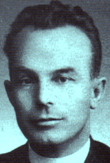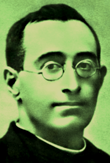




Blessed Phila Agnese, Lucia Khambang and 4 companions
Protomartyrs of Thailand
m. Songkhon (Thailand), December 26, 1940
Roman Martyrology: In the village of Song-Khon in Thailand, Blessed Martyrs Phila Agnese and Lucia Khambang, virgin of the Sisters Lovers of the Cross, and Agata Phutta, Cecilia Butsi, and Maria Viviana Hampai Phon, shot in the local cemetery because they refused to deny their Christian faith.
Christianity was introduced to Thailand in 1881 and in 1940 the Catholic faithful were already seven hundred. In the four years following, the French missionaries were forced to leave the country during the grip of war between Thailand and French Indochina. As is usual in such circumstances, national unity was regarded as a priority and instead “downgraded” danger to religious pluralism.
Songkhon The village, located on the shores of the Great Mekong River border with Laos, was the scene in 1940 of the glorious martyrdom of seven indigenous Christians: Filippo Siphong Onphitak, Phila Agnese, Lucia Khambang, Agata Phutta, Cecilia Buts, Bibiana Khamphai and Mary Phon.
religious Agnese Phila
Ban nahi (Thailand), 1909 – Songkhon (Thailand), December 26, 1940
Agnese Phila (in the Margaret) was born in 1909 in the village of Ban pay nahi, daughter of Joachim and Anna Thit Son Chum. The family then emigrated in the Christian village of Viengkhuk, where the Blessed received the baptism in 1924. Her godmother was the aunt of the famous Sister Lucia of Fatima. On December 7 she made her entry into the Congregation of the Lovers of the Cross at Siengvang in Laos. Two years after the Nov. 26 entry, her postulancy began Nov. 10 and in 1927 she entered the order with the name of Agnes the novitiate, which culminated with the occupation on November 16, 1928. In 1932 he was sent as a teacher at the school in Songkhon, where she was killed on December 26, 1940.
religious Lucia Khambang
Viengkhuk (Thailand), Jan 22, 1917 – Songkhon (Thailand), December 26, 1940
Lucia was born in the Khambang Christian village of Viengkhuk Jan 22, 1917, daughter of James and Mary Mag Dam Li. She was christened on March 10, while on June 4, 1925, when she was only eight years old, she received the sacrament of Confirmation and received for the first time the Holy Communion. On September 3, 1931 she entered the Congregation of the Lovers of the Cross. A postulant for three years, she began the novitiate on October 8, 1935 that lasted two years. Issued her profession to Siengvang in Laos on October 15, 1937. At the beginning of 1940 she was sent as a teacher Songkhon, where she was killed on December 26, 1940 at just twenty-years old.
Agata Phutta secular
Bi Keng Ban Pho (Thailand), 1881 – Songkhon (Thailand), December 26, 1940
Agata Phutta was born in the village of Bi Keng Ban Pho in 1881 from a pagan family. Only daughter, she converted to Christianity at thirty and was baptized and confirmed on March 3, 1918 in Siengvang. Being unmarried, she decided to serve in the kitchens of missions Songkhon, Mong Seng, Pkasè and again Songkhon, where she lived when she was also killed on December 26, 1940 at fifty-nine years of age.
Cecelia Butsi girl lay
Songkhon (Thailand), Dec 16, 1924 – Songkhon (Thailand), December 26, 1940
Cecilia Buts, daughter of Amato and Sinuen Thep Agata, was born at Songkhon December 16, 1924 and was christened after only two days. Officer to the kitchen of the mission, hers was a joyful and courageous character. The first day of martyrdom, during a meeting before the church, she declared herself Christian despite the death threats suffered by the police. She was then killed on December 26, 1940, at just sixteen.
Bibiana Khamphai girl lay
Songkhon (Thailand), Nov 4, 1925 – Songkhon (Thailand), December 26, 1940
Bibiana Khamphai was born in Songkhon November 4, 1925, daughter of Benedict and Lon Monica Di. She was baptized and confirmed less than two months after Dec. 28. A teenager with irreproachable conduct, good Christian, assiduous about the sacraments, attended the mission Songkhon, was also killed on December 26, 1940, at just fifteen years of age.
Maria Phon girl lay
Songkhon (Thailand), Jan 6, 1925 – Songkhon (Thailand), December 26, 1940
Maria was born in Phon Songkhon on January 6, 1926 to parents John the Baptist and Catherine Tan Pha. Just six days after birth was already baptized and confirmed. She lived with an aunt named Mary and attended the local mission. Particularly diligent in the Eucharist and other sacraments, was also killed on December 26, 1940, not yet fifteen.
But even hours dwell on all the events that led these women to spread Christian Thai their blood for Christ. The evening after the killing of the catechist Philip Siphong Onphitak the news is sparse at Songkhon, causing great sadness. The soldiers, hoping to convert the faithful, but had not calculated the presence of both religious Agnes Phila and Lucia Khambang, who realized that soon would come the time to give them the very witness of their faith.
Lu tried by every means to persuade the nuns to abandon their religion, but failed several attempts on the evening of Christmas summoned the entire village before the church, to communicate that he had received the order to destroy the Christian religion at the cost of killing faithful. During the night the sisters then wrote a letter to Lu arguing they were ready to die rather than deny Christ. Lu later returned to in the early afternoon asking: “So, your God, abandoned, yes or no?”. They argue: “No, not ever leave.” Lu invited the then descend to the river, but Sister Lucia and Sister Agnes, understanding his intention, preferred to be shot in the cemetery. Here, kneeling against a tree trunk, they were executed with young Cecilia, Bibiana and Mary. They were then buried in Songkhon.
The beatification of these seven Thai martyrs, was celebrated in Rome by Pope John Paul II on October 22, 1989 following the recognition of their heroic martyrdom which took place on September 1, 1988.
Author: Fabio Arduino
SOURCE: Santi e Beati










.jpg)






















